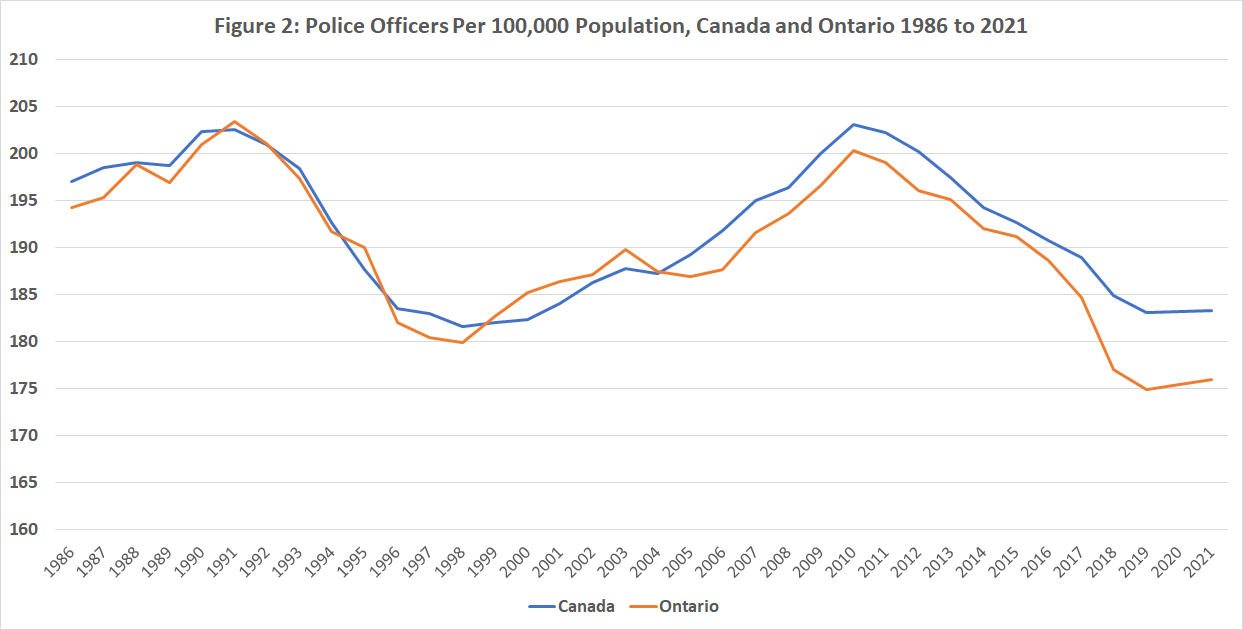Policing and Crime in Ontario, Part 1: proposals for more money

This is the first post in a blog series exploring the state of policing levels and crime rates in Ontario.
Municipal budget season in Ontario comes with an assortment of budgetary issues including proposed hefty increases in policing budgets partly fuelled by rising crime rates.
Recent proposals include:
- A 4.3 per cent increase of police spending in Toronto, which would increase the police budget by $48.3 million to $1.17 billion, and an increase of 200 officers (in light of a planned 5.5 per cent increase in property taxes, this proposal has generated much debate).
- A 5.6 per cent increase in the police budget in Sudbury, accompanied by a proposal for 15 new officer cadet hires and ultimately 24 new officer positions. The proposed hires come at a time when crime rates have not fluctuated a great deal.
- In Hamilton, the Police Services Board asked for a 6.7 per cent increase ($12 million) in its budget that includes 18 new civilian positions and 13 new officers yearly.
- In Thunder Bay, a proposed increase in the police budget for 2023 accounts for about one-third of the proposed 6.2 per cent tax levy increase and also includes the hiring of 21 positions.
When proposing these large budget requests, advocates often cite the effects of capital renewal, general inflation of operating costs, rising demand for police services given their more complicated roles (especially with respect to social and mental health issues) and rising crime rates—that is, the number of police service reported criminal code incidents per 100,000 population. As chart below shows, crimes rates in both Canada and Ontario have grown since 2015 but took a sharp drop in 2020 (the first pandemic year) and then resumed upwards.
However, by historical standards crime rates remain quite low. At the same time, policing numbers in both Canada and Ontario are also at comparatively low levels in terms of officers per 100,000 population over the 1986 to present period (see second chart below). Since the mid-1980s, there have been two peaks in officers per 100,000—1991 and 2010. Both peaks were followed by declines in the number of officers but the decline after 2010 appears more pronounced with officers per 100,000 population in Ontario declining from 200.3 in 2010 to 174.9 in 2019 (a 13 per cent drop) followed by a slight rebound to 176 by 2021.
Given these numbers are per 100,000 people, another factor in the demand for more officers is simply Ontario’s rapid population growth. Since 2010, Ontario’s population has increased from 13.1 million to 14.8 million (an increase of 13 per cent) while the total number of police officers has remained flat, hence the per-person decline.
In general, public debate on rising police costs should be considered within the context of overall public spending in Canada and the demands of a more complex society. Policing has evolved beyond just dealing with crime and includes a wider range of problem social behaviours, which are factors in police resource and expenditure growth.
The key question then in municipalities across Ontario is what should municipal councils do in response to demands for more policing? To answer that, we must know what the relationship between police resources and crime is and how that might shape the assorted requests across the province for larger police budgets. Given the diversity that is Ontario, in terms of the size and needs of its urban centres, there’s not a one-size-fits-all answer to such questions. In the next post in this series, we’ll explore the relationship between police staffing and crime severity across major Ontario municipalities.



